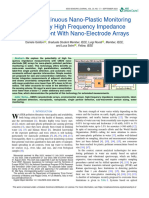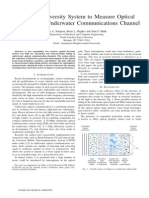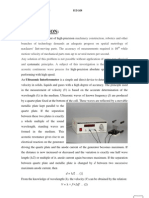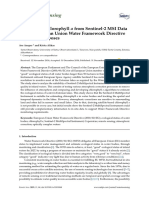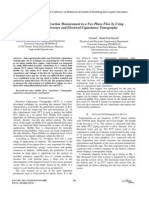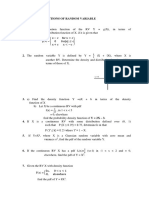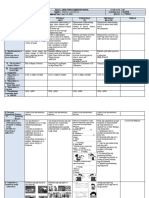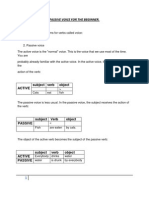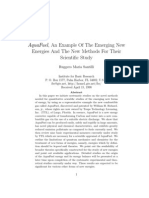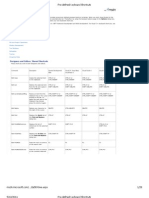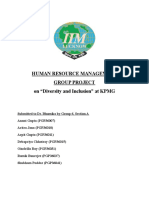A Non-Specific Microwave Sensor For Water Quality Monitoring
A Non-Specific Microwave Sensor For Water Quality Monitoring
Uploaded by
Gianluca GennarelliCopyright:
Available Formats
A Non-Specific Microwave Sensor For Water Quality Monitoring
A Non-Specific Microwave Sensor For Water Quality Monitoring
Uploaded by
Gianluca GennarelliOriginal Title
Copyright
Available Formats
Share this document
Did you find this document useful?
Is this content inappropriate?
Copyright:
Available Formats
A Non-Specific Microwave Sensor For Water Quality Monitoring
A Non-Specific Microwave Sensor For Water Quality Monitoring
Uploaded by
Gianluca GennarelliCopyright:
Available Formats
International Water Technology Journal, IWTJ
Vol. I - Issue 3, December 2011
A non-specific microwave sensor for water quality monitoring
G. Gennarelli, F. Soldovieri
Institute for the Electromagnetic Sensing of the Environment, National Research Council of Italy,
Via Diocleziano, 328-80124 Napoli, Italy.
E-mail: gennarelli.g@irea.cnr.it
ABSTRACT
This paper deals with a microwave measurement system for the real-time monitoring of water
quality. The sensor is a compact cavity resonator tuned at 1.91 GHz which has been designed by a
Finite Element Method code to maximize the Q-factor. The sensing principle relies on the changes of
the device response in terms of the transmitted power, resonance frequency, and 3-dB bandwidth.
These variations are caused by the change of the permittivity and conductivity of the water sample
under test induced by the presence of pollutants. Experiments are carried out in laboratory conditions
on water solutions contaminated with different substances. As shown, the system is capable to reliably
detect the presence of nitrates and sulfites dissolved in water in concentrations above 10 mg/L. The
proposed set-up is portable and thus particularly tailored for its deployment on-field. Moreover, it has
reduced cost since it does not necessitate expensive instrumentation such as network analyzers.
Keywords: microwave sensor, nitrates, sulfites, water pollution analysis.
1. INTRODUCTION
Water pollution concerns any chemical, physical or biological variation in the quality of water which
exceeds some reference values and may cause health problems. The most evident ones are the result of
microbial (bacteriological, viral, protozoan or other biological) contamination which usually arises in
presence of untreated waste and sewage discharges. Nevertheless, an appreciable number of serious
health problems may also occur as a result of chemical contamination. Chemical pollutants are usually
classified into organic and inorganic materials. They may be products expelled from factories, e.g.
industrial solvents, heavy metals, plastics, fertilizers and pesticides which are harmful to humans and
also to all plants and animals in water.
Nowadays, the quality of water intended for human consumption is usually high when it leaves the
purification plant, but it can deteriorate on its way to the consumers for the presence of chemical
substances or because of stagnation in reservoir which may facilitate the growth of algae and bacteria.
As a result, water monitoring is of primary concern for most health and security authorities.
In this framework, the European Directive 98/93/EC [1] has set quality standards of drinking water on
the basis of the guidelines from the World Health Organization (the most recent guidelines can be
found in [2]). In particular, it has fixed the maximum allowed concentrations of several chemical and
microbiological substances based on their maximum daily consumption over long period of times,
their nature and their potential toxicity.
Water quality sensors exploiting different technologies (e.g. chemical, optical, acoustic, etc.) have
been presented in the literature [3]-[9]. Moreover, many commercial solutions are currently available
on the market and commonly adopted to analyze specific parameters of interest such as PH,
conductivity, free and residual chlorine concentration, dissolved oxygen, turbidity, etc. Sometimes
these features can be even monitored by a single multi parameter sonde which provides much more
flexibility at the expense of a major complexity and cost.
International Water Technology Journal, IWTJ
Vol. I - Issue 3, December 2011
However, real-time monitoring of drinking water can involve the presence of several sensors deployed
along the distribution network. In this scenario, it may be convenient to use non-specific devices,
possibly low-cost, which are sensitive to several impurities instead of many specific sensors each
sensitive to a single substance. For instance, to reduce the complexity and the cost of the overall
monitoring system, it may be sufficient at an early stage to measure only the variations, with respect to
some nominal conditions, of some typical sensor parameters. Only when significant variations are
recorded, detailed analyses with specific sensors are carried out.
The aim of this paper is to demonstrate the feasibility to detect water contaminants by exploiting
microwave technology. The sensing device here considered is a rectangular cavity resonator working
at 1.91 GHz in the fundamental TE101 mode. The basic idea is to introduce a water sample inside the
cavity by means of a low loss capillary. As well-known, the presence of pollutants in water alters the
complex permittivity of the solution (i.e. the dielectric permittivity and conductivity) [9] thus
modifying the cavity response in terms transmitted power, resonance frequency and 3-dB bandwidth.
As a consequence, it is possible to detect the pollutants by monitoring these parameters in real-time. It
must be stressed that the sensor is non-specific, i.e. it is not capable to discriminate the type of
contaminants and their respective concentrations without a-priori information on the solution
composition and the availability of proper calibration curves. This point is easily understood since the
same permittivity and/or conductivity variations could be for instance induced by different substances
or different combinations of substances.
Cavity perturbation methods have been widely investigated in the past years for characterizing the
dielectric behavior of materials at microwave frequencies [10]. Moreover, their application water
pollution analysis has been considered in [12] and [13]. Unlike these works, here we propose a novel
cavity design and portable measurement system suitable for on field applications. Moreover, the main
contribution is the appraisal of the achievable sensing performance in terms sensitivity and lowest
detectable concentrations.
The paper is organized as follows. Section 2 provides the description of the sensor, its working
principle and design parameters. The measurement system and the characterization of several polluted
waters are presented in Section 3. Conclusions follow in Section 4.
2. THE CAVITY SENSOR
A drawing of the rectangular cavity-based sensor also comprising the elements for signal coupling is
depicted in Fig. 1. The structure is made of aluminum and has dimensions a , b , and l along the x, y,
and z axis, respectively. Such dimensions are fixed to a = l = 11.065 cm and b = 5.45 thus giving a
fundamental resonant TE101 mode at the frequency 1.9158 GHz. The structure is coupled to the
external circuit via coaxial probes connected to 50 Ohm cables. The probes are inserted in the cavity
via holes drilled in the bottom wall. Their geometrical features have been optimized by using a Finite
Element (FEM) code in order to maximize the Q-factor, i.e., frequency selectivity. Based on this
optimization, a resonant frequency of 1.915 GHz and a Q-factor of 3800 have been experimentally
determined. These values are in good agreement with the simulation results (errors less than 1 %).
More details on the design of the cavity and the characterization of its operation are available in a
recent paper [13] dealing with the usage of this device as concentration sensor for binary liquid
mixtures.
As shown in Fig. 1, a cylindrical capillary with radius rc passes through the cavity at its center where
the electric field is maximum to allow the water flow. The water sample to be analyzed is modeled as
a dielectric material characterized by the complex relative permittivity = ' j '' = '(1 j tan ) ,
where ' and '' are the real and imaginary parts and tan is the loss tangent.
According to resonant perturbation theory [10], the presence of a water solution inside the capillary
gives rise to a shift of the resonant frequency and an increase of the 3-dB bandwidth (reduction of the
Q-factor) with respect to the empty cavity case. Of course, the amount of these perturbations depends
on sample volume as well as on its dielectric properties, i.e. its chemical composition. Based on the
same principle, a variation of the electromagnetic properties of water caused by contaminants is
International Water Technology Journal, IWTJ
Vol. I - Issue 3, December 2011
Fig. 1 Sketch of the rectangular cavity and its coupling elements.
expected to produce a change of the resonance frequency and of the 3-dB bandwidth. Moreover, also
the reflected and transmitted powers at the ports of the cavity (ports 1 and 2 in Fig. 1) vary.
In order to get insight into the physical behavior of the sensor when it is filled with water samples,
numerical simulations are carried out with the FEM method. An example showing the transmission
coefficient S21 of the cavity is reported in Fig. 2. The effect of the capillary radius as well as of the
complex permittivity is investigated (see caption of Fig. 2 for further details). Once ' and '' ( tan )
are fixed, increasing rc yields a higher resonant frequency shift and a broadening of the 3-dB
bandwidth. Moreover, increasing the sample radius yields a higher sensitivity with respect to complex
permittivity changes (see in particular the curves relevant to rc = 1.5 mm). Figure 2 also reveals that
the transmission peak of the S21 coefficient lowers with the sample volume. In a similar way, the
reflection coefficient at the input port (not shown) is strongly influenced by the sample volume and the
mismatch increases with rc . Accordingly, depending on the type of liquid to be characterized, a
limitation on the maximum sample volume is expected in practice. Note also that the accuracy of the
resonant frequency evaluation is directly related to the Q-factor and to the signal-to-noise ratio on
measured data [14].
15
rc = 0.5 mm
20
25
rc = 1 mm
S21 (dB)
30
35
rc = 1.5 mm
40
45
50
55
60
1.7
1.75
1.8
f (GHz)
1.85
1.9
Fig. 2 Simulated transmission coefficient for different sample radii and dielectric constants. The solid
curves refer to '=74 whereas the dashed lines are related to '=75 . The dielectric loss tangent is equal to
0.05.
International Water Technology Journal, IWTJ
Vol. I - Issue 3, December 2011
3. EXPERIMENTAL ANALYSIS
In this Section, the results of laboratory tests carried out in controlled conditions at IREA-CNR are
reported. A photo of the measurement set-up is shown in Fig. 3. The cavity-based sensor is fed at the
input port by a synthesized RF signal generator (mod. SSG-4000LH manufactured by Mini Circuits)
and the power transmitted at the output port is measured by a power meter (mod. PWR-4RMS
produced by Mini Circuits). Both devices are programmable and communicate via USB with a laptop
which represents the control unit. The RF generator transmits CW signals over the frequency range
[1815, 1840] MHz with a step of 200 KHz and acquires each resonance curve in about 20 seconds.
Then, the resonance frequency and the 3-dB bandwidth are extracted from measured curve by a
Lorentzian fitting method [14]. A software has been developed to easily configure measurement
parameters, acquire the data, process them and display the results in real-time.
The water solutions are introduced in the cavity via a thermoplastic capillary of inner radius equal to 1
mm and thickness of 1 mm. In particular, the capillary is connected to an external pump via tube
fittings so that a continuous water flow is created and no air bubbles are formed in the capillary. The
temperature of the liquid under test is kept constant at 25C using a thermostatic bath (mod. Lauda
M12). As will be shown, temperature variations represent a key point that must be taken into account.
As a matter of fact, they alter the electromagnetic properties of the solution under test thus lowering
the sensor capability to detect pollutants.
The water contaminants considered for the experiments are potassium-nitrate (KNO3) and potassiumsulfite (K2S2O5). Nitrates are generally not extremely toxic but their reduction to nitrites can lead to a
generalized lack of oxygen in organ tissue and a dangerous condition called methemoglobinemia [2].
Their allowed maximum concentration is fixed by law to 50 mg/L. As regards the potassium-sulfite
(K2S2O5), it is commonly employed as an additive for food conservation and it can cause allergies to
sensitive people. However, no guidelines values are available for it.
Several water-KNO3 and water-K2S2O5 samples are prepared with growing solute concentrations in
the range [0, 500] mg/L. For each concentration value, ten measurements are collected in order
perform an estimate of measurement errors. The sensor response is evaluated only in terms of
transmitted power at resonant frequency and 3-dB bandwidth since the resonance frequency changes
are less detectable for the considered solutions. This point is clearly highlighted by the results shown
in Fig. 4 concerning the measured power versus frequency in the case of water-KNO3 solutions. Note
that increasing the nitrate concentration mainly lowers the peak power and increases the bandwidth
due to the higher conduction losses.
Starting from the measured curves, the average (mean value) variation of the transmitted power at the
resonance frequency and of the 3-dB bandwidth are computed and plotted versus the KNO3
concentration in Figs. 5 a and b, respectively. As can be seen, these quantities well agree with a linear
model. Moreover, the sensitivity to peak power variation is 0.0018 (dBm/(mg/L)), whereas that related
to the 3-dB bandwidth variation is equal to 3.8 (KHz/(mg/L)).
Fig. 3 A photograph of the measurement system.
International Water Technology Journal, IWTJ
Vol. I - Issue 3, December 2011
27
28
Transmitted power (dBm)
29
30
31
KNO3=0 mg/L
KNO3=100 mg/L
KNO3=200 mg/L
32
KNO3=300 mg/L
KNO3=400 mg/L
33
34
1810
KNO3=500 mg/L
1815
1820
1825
1830
f (MHz)
1835
1840
1845
0.7
1.4
0.6
1.2
Change of 3dB bandwidth (MHz)
Change of peak power (dBm)
Fig. 4 Transmitted power versus frequency for different water-KNO3 solutions. Only one measurement is
shown for each concentration value to improve results readability.
0.5
0.4
0.3
0.2
0.1
1
0.8
0.6
0.4
0.2
Linear fit
Data
0
0
100
200
300
concentration (mg/L)
400
Linear fit
Data
0
0
500
100
200
300
concentration (mg/L)
400
500
(a)
(b)
Fig. 5 Measurement results (mean values and error bars) and the linear fit curve for water-KNO3
solutions. (a) Variation (modulus) of the peak power. (b) Variation of the 3-dB bandwidth.
After, we analyze the water-K2S2O5 samples for the same concentrations of solute. The results
obtained in this case, plotted in Figs. 6 a and b, reveal similar trends as for the water-KNO3 solutions,
and the main difference is a reduction of the sensor sensitivities (0.001 dBm/(mg/L) and 2.1
KHz/(mg/L)).
Linear fit
Data
Linear fit
Data
1.2
Change of 3dB bandwidth (MHz)
Change of peak power (dBm)
0.6
0.5
0.4
0.3
0.2
0.1
0
0
0.8
0.6
0.4
0.2
100
200
300
concentration (mg/L)
400
500
0
0
100
200
300
concentration (mg/L)
400
500
(a)
(b)
Fig. 6 Measurement results (mean values and error bars) and the linear fit curve for water-K2S2O5
solutions. (a) Variation (modulus) of the peak power. (b) Variation of the 3-dB bandwidth.
International Water Technology Journal, IWTJ
Vol. I - Issue 3, December 2011
Based on the above results, we perform an estimation of the Limit of Detection (LoD), i.e., the
minimum detectable concentration for a given pollutant. To this end, the standard deviations of the
sensor response have been evaluated on a water sample. The sensor performance achieved is
summarized in Tab. 1 and, as can be noted, they confirm the feasibility to detect pollutant
concentrations in excess of 10 mg/L.
Table 1 Sensor performance at 25 C
Solution
Power sensitivity Bandwidth sensitivity Power LoD Bandwidth LoD
(dB/(mg/L))
(KHz/(mg/L))
(mg/L)
(mg/L)
WaterKNO3
0.0013
2.6
0.001
2.1
WaterK2S2O5
Finally, we investigate the effects on the sensor response caused by temperature variations
intentionally induced with the thermostatic bath. This analysis is accomplished to estimate the
temperature sensitivities which may aid to compensate unwanted temperature changes arising when
the sensor is needed to operate on field. In particular, the temperature of a water solution is
progressively increased by steps of 1 C in the interval [20, 25] C. The variations of the transmitted
power, resonance frequency and 3-dB bandwidth versus temperature are plotted in Figs. 7 a, b, and c.
In this case, increasing the temperature lowers the permittivity and conductivity of the solution with a
resulting increase of the peak power, of the resonant frequency, and reduction of the bandwidth.
Moreover, the trends are linear and the sensitivity of power variation is equal to 0.2 dBm/C, the
sensitivity of resonant frequency is 400 KHz/C, and that relevant to bandwidth is equal to 380
KHz/C.
27
1828
21
Linear fit
Data
Linear fit
Data
27.5
20.5
3dB bandwidth (MHz)
Resonance frequency (MHz)
Peak power (dBm)
1827.5
1827
1826.5
1826
28
20
19.5
19
Linear fit
Data
20
21
22
23
T (C)
24
25
1825.5
20
21
22
23
T (C)
24
25
18.5
20
21
22
23
24
25
T (C)
(a)
(b)
(c)
Fig. 7 Measurement results (mean values and error bars) and the linear fit curve for water versus
temperature in the range [20, 25]C. (a) Transmitted peak power. (b) Resonance frequency (c) 3-dB
bandwidth.
4. CONCLUSIONS
A non-specific microwave cavity sensor has been proposed as a useful tool for real-time water
pollution analysis. The measurement system here considered is portable and has a relative low cost
with respect to more expensive solutions based on network analyzers. Experimental tests have
confirmed that the sensor is capable to detect pollutants such as nitrates and sulfites dissolved in water
at concentrations above 10 mg/L regardless of the parameter measured. These results turn out to be
very promising and suggest that, if temperature variations of the liquid under test are monitored and
compensated, it is possible to detect the presence of various pollutants of practical interest.
International Water Technology Journal, IWTJ
Vol. I - Issue 3, December 2011
ACKNOWLEDGMENTS
This research has received funding from the Italian Ministero dello Sviluppo Economico,
under Grant Agreement "Industria 2015 - New Technologies for the Made In Italy", No. MIOl
00223 (project ACQUASENSE).
REFERENCES
[1]
[2]
[3]
[4]
[5]
[6]
[7]
[8]
[9]
[10]
[11]
[12]
[13]
[14]
Council directive 98/83/EC of 3 November 1998 on the quality of water intended for human
consumption, L 330/32 EN, Official Journal of the European Communities.
Guidelines for drinking-water quality 4th edition, World Health Organization, 2011.
J. Wang, R. K. Bhada, J. Lu, D. MacDonald, Remote electrochemical sensor for monitoring
TNT in natural waters, Analytica Chimica Acta, vol. 361, pp. 85-91, 1998.
J. W. Gardner, H. W. Shin, E. L. Hines, C. S. Dow, An electronic nose system for monitoring
the quality of potable water, Sensors and Actuators B, vol. 69, pp. 336341, 2000.
W. Bourgeois, P. Hogben, A. Pike, R. M. Stuetz, Development of a sensor array based
measurement system for continuous monitoring of water and wastewater, Sensors and Actuators
B, vol. 88, pp. 312-319, 2003.
E. M. Nolan and S. J. Lippard, A Turn-On fluorescent sensor for the selective detection of
mercuric ion in aqueous media, J. Am. Chem. Soc., vol. 125, pp. 14270-14271, 2003.
E. S. Forzani, H. Zhang, W. Chen, and N. Tao, Detection of heavy metal ions in drinking water
using a high-resolution differential surface plasmon resonance sensor, Environ. Sci. Technol.,
vol. 39, pp. 1257-1262, 2005.
M. I. S. Verssimo, M. T. S. R. Gomes, The quality of our drinking water: aluminium
determination with an acoustic wave sensor, Analytica Chimica Acta, vol. 617, pp. 162166,
2008.
O. Korostynska, A. Mason, A. Al-Shammaa, Monitoring of nitrates and phosphates in
wastewater: current technologies and further challenges, International Journal on Smart Sensing
and Intelligent Systems, vol. 5, no. 1, pp. 149-176, 2012.
L. Chen, C. Ong, C. Neo, V. V. Varadan, and V. K. Varadan, Microwave electronics:
Measurement and materials characterization, John Wiley and Sons, New-York, 2004.
H. J. C. Blume, Measurement of dielectric properties and determination of microwave
emissivity of polluted waters, IEEE Trans. Instrum. Measur., vol. 29, no. 4, pp. 289-291, 1980.
U. Raveendranath, and K. T. Mathew, Microwave technique for water pollution study, Journal
Microwave Power and Electromagnetic Energy, vol. 30, no. 3, pp. 188-194, 1995.
G. Gennarelli, S. Romeo, M. S. Scarfi, F. Soldovieri, A microwave resonant sensor for
concentration measurements of liquid solutions, IEEE Sensors Journal, vol. PP, no.99, pp.1, 0.
R. Inoue et al., Data analysis of the extraction of dielectric properties from insulating substrates
utilizing the evanescent perturbation method, IEEE Trans. Microwave Theory Tech., vol. 54, no.
2, pp. 522-532, 2006.
You might also like
- Soap Notes HypertensionDocument6 pagesSoap Notes HypertensionCHRISTINE KARENDI100% (1)
- Lab Report #1: Specific Gravity of Soils and Moisture ContentDocument7 pagesLab Report #1: Specific Gravity of Soils and Moisture ContentJoanna Gamboa100% (5)
- Toward Continuous Nano-Plastic Monitoring in Water by High Frequency Impedance Measurement With Nano-Electrode ArraysDocument9 pagesToward Continuous Nano-Plastic Monitoring in Water by High Frequency Impedance Measurement With Nano-Electrode ArraysSupriya GowdaNo ratings yet
- Underwater Communications in Wireless Sensor Networks Using Wlan at 2.4 GHZDocument6 pagesUnderwater Communications in Wireless Sensor Networks Using Wlan at 2.4 GHZgomu85No ratings yet
- 3) Metodo de Baixo Cuso - Nivel - Capacitivo 122 Paper-F - ReverterDocument5 pages3) Metodo de Baixo Cuso - Nivel - Capacitivo 122 Paper-F - ReverterAlan BartoskiNo ratings yet
- Adrian Nicolescu and Marcel Dobre - Quantum Microwave - Compost Interaction ModelDocument7 pagesAdrian Nicolescu and Marcel Dobre - Quantum Microwave - Compost Interaction ModelOppekeeNo ratings yet
- Manuscript Level IET Update 22092023Document12 pagesManuscript Level IET Update 22092023subhankar.tig1No ratings yet
- Investigating Effect of Temperature On Dielectric Response of Bound Water in GrainDocument3 pagesInvestigating Effect of Temperature On Dielectric Response of Bound Water in GrainngayhevuiNo ratings yet
- Flow Measurement 2001 - International Conference - Creating Efficiency Across Industry SectorsDocument13 pagesFlow Measurement 2001 - International Conference - Creating Efficiency Across Industry SectorsSArulManojNo ratings yet
- Sensor de Conductividad en Calidad Del AguaDocument7 pagesSensor de Conductividad en Calidad Del AguaCesar BuitragoNo ratings yet
- Acoustic Properties of The Elastomeric Materials Aqualene and ACEDocument12 pagesAcoustic Properties of The Elastomeric Materials Aqualene and ACEPetrNo ratings yet
- Conductivity Effect On The Capacitance Measurement of A Parallel-Plate Capacitive Sensor SystemDocument8 pagesConductivity Effect On The Capacitance Measurement of A Parallel-Plate Capacitive Sensor SystemKrisna SinghNo ratings yet
- A Small Diameter Ultrasonic Water Meter With Self-Diagnosis Function and Self-Adaptive TechnologyDocument13 pagesA Small Diameter Ultrasonic Water Meter With Self-Diagnosis Function and Self-Adaptive TechnologyXiong ChwNo ratings yet
- Dielectric Properties of Aqueous NaCl SolDocument6 pagesDielectric Properties of Aqueous NaCl SolPratik ChatterjeeNo ratings yet
- Ultrasound Velocity in Liquid MediaDocument13 pagesUltrasound Velocity in Liquid MediaAndrea EspinosaNo ratings yet
- PreviewDocument11 pagesPreviewDjoeg_faceNo ratings yet
- Capacitance Sensor For Void Fraction Measurement in Water-Steam FlowsDocument8 pagesCapacitance Sensor For Void Fraction Measurement in Water-Steam Flowsagnotts2009No ratings yet
- Applied: Applied Applied Applied Applie Applied ..Document9 pagesApplied: Applied Applied Applied Applie Applied ..Bruno GonçalvesNo ratings yet
- Term 20211: Section EPW10 ECE 379: Smart Sensors ONLINE Assignment No.2Document16 pagesTerm 20211: Section EPW10 ECE 379: Smart Sensors ONLINE Assignment No.2Chandu ParitalaNo ratings yet
- An Inductive Sensor For WaterDocument7 pagesAn Inductive Sensor For WaterYair RoblesNo ratings yet
- Molecular Relaxation Effects On Vibrational Water Vapor Photoacoustic Spectroscopy in AirDocument18 pagesMolecular Relaxation Effects On Vibrational Water Vapor Photoacoustic Spectroscopy in AirАртем КлимчукNo ratings yet
- Study On Leakage Current Waveforms and Flashover of Ceramics For Outdoor Insulators Under Artificially-Simulated PollutionsDocument7 pagesStudy On Leakage Current Waveforms and Flashover of Ceramics For Outdoor Insulators Under Artificially-Simulated PollutionsnelmaheshNo ratings yet
- Manuscript Level IETDocument11 pagesManuscript Level IETsubhankar.tig1No ratings yet
- A Spatial Diversity System To Measure Optical Fading in Underwatrer Communications ChannelDocument6 pagesA Spatial Diversity System To Measure Optical Fading in Underwatrer Communications Channelpeppas4643No ratings yet
- Welcome To International Journal of Engineering Research and Development (IJERD)Document6 pagesWelcome To International Journal of Engineering Research and Development (IJERD)IJERDNo ratings yet
- Ultrasonic InterferometerDocument13 pagesUltrasonic Interferometerwasif2886% (7)
- Bubble Size and Velocity Measurement in Gas-Liquid Systems: Application Fiber Optic Technique To Pilot Plant ScaleDocument5 pagesBubble Size and Velocity Measurement in Gas-Liquid Systems: Application Fiber Optic Technique To Pilot Plant ScaleAmin SmileyNo ratings yet
- 2012 Water EPI Structered WaterDocument17 pages2012 Water EPI Structered Waterambertje12No ratings yet
- Turbulence in Micro-ChannelsDocument8 pagesTurbulence in Micro-Channelstinhtt2001No ratings yet
- Direct Determination of Moisture in Solid Oil-Paper InsulationDocument4 pagesDirect Determination of Moisture in Solid Oil-Paper InsulationJuan PabloNo ratings yet
- Sensors 09 07431 PDFDocument14 pagesSensors 09 07431 PDFFamiloni LayoNo ratings yet
- Liquid Antenna 1Document11 pagesLiquid Antenna 1Mansour ElmabroukNo ratings yet
- Blast AttenuationDocument10 pagesBlast Attenuationraymond MARTINo ratings yet
- IP Marine ProfilingDocument10 pagesIP Marine ProfilingRandiRusdianaNo ratings yet
- Sensors: Underwater Wireless Sensor Communications in The 2.4 GHZ Ism Frequency BandDocument28 pagesSensors: Underwater Wireless Sensor Communications in The 2.4 GHZ Ism Frequency BandKartikNo ratings yet
- Soil Moisture Measurement InstrumentationDocument8 pagesSoil Moisture Measurement InstrumentationNguyen Di KhanhNo ratings yet
- Field Measurements of Sheet Flow Sediment Transport in The Swash ZoneDocument7 pagesField Measurements of Sheet Flow Sediment Transport in The Swash ZoneAlirezaKhoshkoneshNo ratings yet
- Dielectrophoretically Assembled Polymer Nanowires For Gas SensingDocument5 pagesDielectrophoretically Assembled Polymer Nanowires For Gas SensingMuhammad Tayyab ZahoorNo ratings yet
- Sensors: A Capacitive Humidity Sensor Based On Multi-Wall Carbon Nanotubes (MWCNTS)Document14 pagesSensors: A Capacitive Humidity Sensor Based On Multi-Wall Carbon Nanotubes (MWCNTS)cayo16No ratings yet
- Indepth Diagnosis of A Secondary Clarifier by The Application of Radiotracer Technique and Numerical ModelingDocument11 pagesIndepth Diagnosis of A Secondary Clarifier by The Application of Radiotracer Technique and Numerical Modeling305773253No ratings yet
- White Paper - ConductivityDocument10 pagesWhite Paper - ConductivityWalid FattahNo ratings yet
- Dielectric Logging PDFDocument3 pagesDielectric Logging PDFWilson Ling Kuok HungNo ratings yet
- Characterization of Atmospheric Pressure Discharges: R.Barni, S.Zanini, R.Siliprandi, P.Esena, C.RiccardiDocument8 pagesCharacterization of Atmospheric Pressure Discharges: R.Barni, S.Zanini, R.Siliprandi, P.Esena, C.RiccardiRodrigo RamosNo ratings yet
- Sensors: An Affordable Open-Source TurbidimeterDocument14 pagesSensors: An Affordable Open-Source TurbidimeterCris To PherNo ratings yet
- Low-Cost, Tiny-Sized MEMS Hydrophone Sensor For Water Pipeline Leak DetectionDocument9 pagesLow-Cost, Tiny-Sized MEMS Hydrophone Sensor For Water Pipeline Leak DetectionBrendon SoongNo ratings yet
- Anisper ADocument26 pagesAnisper AArega GenetieNo ratings yet
- A Wireless-Transfer-Based Hydrogen Gas Sensing System With A Pd/Algan/Gan Heterostructure Field-Effect Transistor (Hfet)Document6 pagesA Wireless-Transfer-Based Hydrogen Gas Sensing System With A Pd/Algan/Gan Heterostructure Field-Effect Transistor (Hfet)dabalejoNo ratings yet
- ME 472 İnterim Proposal ReportDocument7 pagesME 472 İnterim Proposal ReportBarış ÖzdemirNo ratings yet
- Complex Permittivity of Water As A Function of Frequency and TemperatureDocument4 pagesComplex Permittivity of Water As A Function of Frequency and TemperatureDaniel Henrique100% (1)
- IJRFCADDocument10 pagesIJRFCADGulam AlsathNo ratings yet
- A Microtensiometer Capable of Measuring Water Potentials Below - 10 MPa. - Pagay Et Al. - Lab On A Chip - 2014Document12 pagesA Microtensiometer Capable of Measuring Water Potentials Below - 10 MPa. - Pagay Et Al. - Lab On A Chip - 2014themikemachineNo ratings yet
- Tissue Equivalence of Some Phantom Materials For Proton BeamsDocument8 pagesTissue Equivalence of Some Phantom Materials For Proton Beamssexy_boy158No ratings yet
- Study of Void Fraction Measurement in A Two Phase Flow by Using Differential Pressure and Electrical Capacitance TomographyDocument6 pagesStudy of Void Fraction Measurement in A Two Phase Flow by Using Differential Pressure and Electrical Capacitance Tomographysambhurisha mishraNo ratings yet
- Under Water Optical CommunicationDocument49 pagesUnder Water Optical CommunicationAnurag Palakurthi100% (1)
- Msi Cement ACerS 2007Document11 pagesMsi Cement ACerS 2007Somesh KurellaNo ratings yet
- Underwater Optical Wireless Communication NetworkDocument6 pagesUnderwater Optical Wireless Communication Networkbittu258216No ratings yet
- A Matched Bow-Tie Antenna at 433MHz For Use in UndDocument7 pagesA Matched Bow-Tie Antenna at 433MHz For Use in UndShivam GaunsNo ratings yet
- Conductivity Meters: General InformationDocument6 pagesConductivity Meters: General InformationASRI NURDIANANo ratings yet
- Water Remote Sensing: Advancements in Computer Vision Techniques for Water Remote SensingFrom EverandWater Remote Sensing: Advancements in Computer Vision Techniques for Water Remote SensingNo ratings yet
- Fluid Dynamics in Complex Fractured-Porous SystemsFrom EverandFluid Dynamics in Complex Fractured-Porous SystemsBoris FaybishenkoNo ratings yet
- UTS Reviewer FINALSDocument15 pagesUTS Reviewer FINALSKarla Jane Kitahama Patosa100% (1)
- UNIT2 Probabilty QuestionsDocument4 pagesUNIT2 Probabilty QuestionsDisha GoelNo ratings yet
- Spicer Select Commercial Vehicle: 404 Ring and Pinion GearingDocument4 pagesSpicer Select Commercial Vehicle: 404 Ring and Pinion GearingALAN SELLNo ratings yet
- عؤلميات خاصDocument2 pagesعؤلميات خاصBeghdadi Isaac100% (1)
- Mapeh3 - Q4 - Week 1Document10 pagesMapeh3 - Q4 - Week 1Virgil Acain GalarioNo ratings yet
- Entry Test: Agenda Grammar VocabularyDocument2 pagesEntry Test: Agenda Grammar VocabularyHajnalka SzolykaNo ratings yet
- The Numerical Solution of The Navier-Stokes Equations For An Incompressible FluidDocument4 pagesThe Numerical Solution of The Navier-Stokes Equations For An Incompressible FluidAtul SotiNo ratings yet
- Active Passive Voice For The BeginnresDocument18 pagesActive Passive Voice For The BeginnresWaqas AhmedNo ratings yet
- On The Mechanics of Seepage Induced Cohesionless Soil Slope InstabilityDocument10 pagesOn The Mechanics of Seepage Induced Cohesionless Soil Slope InstabilityHarold MantillaNo ratings yet
- RAM Concrete Shear Wall Design Verification Example (ACI) - V14 PDFDocument21 pagesRAM Concrete Shear Wall Design Verification Example (ACI) - V14 PDFPushpakaran Pillai100% (1)
- Biofuel Production-Recent Developments and ProspectsDocument606 pagesBiofuel Production-Recent Developments and ProspectsRuifei WangNo ratings yet
- Cantalamessa - MT's DarknessDocument30 pagesCantalamessa - MT's DarknesstraperchaperNo ratings yet
- BG 02 Geeta - Sankhya YogaDocument103 pagesBG 02 Geeta - Sankhya Yogasrivatsa100% (1)
- Presupposition AssignmentDocument8 pagesPresupposition Assignmenttahreemsafdar124No ratings yet
- Aquafuel, An Example of The Emerging New Energies and The New Methods For Their Scientific StudyDocument21 pagesAquafuel, An Example of The Emerging New Energies and The New Methods For Their Scientific Studymaadobe27No ratings yet
- Keyboard ShortcutsDocument28 pagesKeyboard Shortcuts74831No ratings yet
- Lesson Plan English AbbreviationDocument3 pagesLesson Plan English Abbreviationapi-300890063No ratings yet
- Final BipDocument14 pagesFinal Bipapi-264266683No ratings yet
- SEM 2 ChecklistDocument2 pagesSEM 2 ChecklistYoussef MansourNo ratings yet
- Qrs Complexes: Fast & Easy Ecgs - A Self-Paced Learning ProgramDocument49 pagesQrs Complexes: Fast & Easy Ecgs - A Self-Paced Learning ProgramMuhammad Hatta HamzahNo ratings yet
- ResearchDocument7 pagesResearchImran MuhammadNo ratings yet
- Vellore Patient's GuideDocument54 pagesVellore Patient's GuideSwarup Sinha100% (3)
- J. 3 I AsmaDocument10 pagesJ. 3 I AsmaSri WahyuniNo ratings yet
- ResearchDocument7 pagesResearchMa Noressa Mañoso Saludar100% (1)
- Human Resource Management Group Project On "Diversity and Inclusion" at KPMGDocument27 pagesHuman Resource Management Group Project On "Diversity and Inclusion" at KPMGDivyanshu MeenaNo ratings yet
- Regular Singular Points: MATH 365 Ordinary Differential EquationsDocument12 pagesRegular Singular Points: MATH 365 Ordinary Differential EquationskenapooluNo ratings yet
- Vastu Shastra by Instituteof Vedic AstrologyDocument13 pagesVastu Shastra by Instituteof Vedic AstrologyInstitute Of Vadic Astrology100% (1)
- Methodology Used in Fdi in IndiaDocument3 pagesMethodology Used in Fdi in IndiaAakriti PatwaryNo ratings yet


